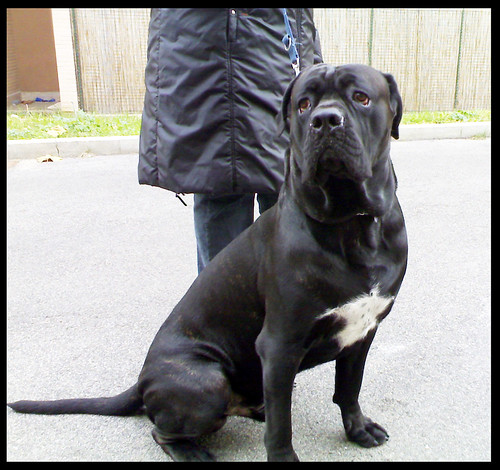The Cane Corso is an Italian breed of dog used mainly as a guard dog. It is of the large molosser type.
The Cane Corso is a large mollossoid. It is well muscled and looks more athletic than most other mastiffs, tending less toward sheer bulk like the English Mastiff and more towards definition like the original Old English Bulldog. The official FCI standard calls for dogs to stand from 60-68cm (23.6-26.7 inches) at the withers, with females in the lower region and males in the higher. Weight should be in keeping with the size and stature of these dogs, ranging from 40-50 kg (88-110lbs). The overall impression should be of power balanced with athleticism.
Its ears are naturally dropped forward, but where legal, many breeders crop them short and close to the head so that the remaining stubs stand upright. Its muzzle is as wide as it is long. Most Corsos have docked tails as well. The standard calls for docking at the 4th vertebra. Some are docked shorter due to unfamiliarity with the breed standard.
Corsos appear in two basic coat colours: black and fawn. This is further modified by genetic pigment dilution to create blue (from black) and formentino (from fawn) colours. Brindling of varying intensity is common on both basic coat colours as well, creating tigrato (full brindle), black brindle, and blue brindle. Fawn also has a number of different expressions, ranging from the pale of a formentino to 'red' to the more common beige colour, with the back coat hairs tipped with black. In blue dogs, the nose can appear grey, but should be darker than the coat. In all other dogs, the nose should be black. White markings on the chest, toes and on the chin are seen as well, with smaller white patches being preferable.
The Cane Corso is a large mollossoid. It is well muscled and looks more athletic than most other mastiffs, tending less toward sheer bulk like the English Mastiff and more towards definition like the original Old English Bulldog. The official FCI standard calls for dogs to stand from 60-68cm (23.6-26.7 inches) at the withers, with females in the lower region and males in the higher. Weight should be in keeping with the size and stature of these dogs, ranging from 40-50 kg (88-110lbs). The overall impression should be of power balanced with athleticism.
Its ears are naturally dropped forward, but where legal, many breeders crop them short and close to the head so that the remaining stubs stand upright. Its muzzle is as wide as it is long. Most Corsos have docked tails as well. The standard calls for docking at the 4th vertebra. Some are docked shorter due to unfamiliarity with the breed standard.
Corsos appear in two basic coat colours: black and fawn. This is further modified by genetic pigment dilution to create blue (from black) and formentino (from fawn) colours. Brindling of varying intensity is common on both basic coat colours as well, creating tigrato (full brindle), black brindle, and blue brindle. Fawn also has a number of different expressions, ranging from the pale of a formentino to 'red' to the more common beige colour, with the back coat hairs tipped with black. In blue dogs, the nose can appear grey, but should be darker than the coat. In all other dogs, the nose should be black. White markings on the chest, toes and on the chin are seen as well, with smaller white patches being preferable.
Cane Corso are considered to have an even, stable temperament. They are easy to train, generally good with children, and calm with their primary guardians. They can be reserved, suspicious and may be aggressive toward people they do not know, if not properly socialized. Corsos tend to be a quiet breed.
The true Corso should be indifferent when approached and should only react when a real threat is present. However, "the majority of the American version of the Corso do not possess the proper temperament for this breed."
The true Corso should be indifferent when approached and should only react when a real threat is present. However, "the majority of the American version of the Corso do not possess the proper temperament for this breed."
As a recently recovered breed, the Cane Corso's history is shrouded in mystery and differing opinions. It is generally agreed that the Cane Corso is a farm dog which has been used for stock control, property and personal protection and big game hunting throughout its history. The breed was recovered from near extinction through the efforts of enthusiasts in the 1980's, the Corso is now popular globally, as can be seen by Lebron James, Laila Ali, and Tracy Morgan's ownership of Cane Corsos.
The Corso is likely derived from the same root stock as the Neapolitan Mastiff; the historically documented Roman war dog "Canes Pugnaces". The Corso favours agility and speed, where the Neapolitan is known for power and strength.
The Corso is likely derived from the same root stock as the Neapolitan Mastiff; the historically documented Roman war dog "Canes Pugnaces". The Corso favours agility and speed, where the Neapolitan is known for power and strength.






Cane Corso Puppies for Sale & Planned Litters. Photos & Info - Please read our Ownership requirements, Prices and Sales Policies. Occasional Corso adults for sale.
ReplyDelete